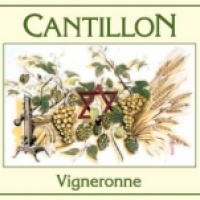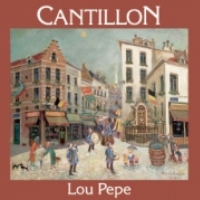Comprar Cantillon Vigneronne - Cantillon Fou’ Foune - Cantillon Lou Pepe Gueuze
The lambic brewers weren't only established in the Senne valley, but also in the valley of the Yssche . This small river has its spring in the Forêt de Soignes and flows through villages like Hoeilaart, Overijse and Huldenberg. In this valley there used to live many brewers who made delicious lambic.
They didn't add cherries or raspberries to their beer, but grapes which had been cultivated in greenhouses. By blending muscat grapes and lambic, the brewers and beer merchants produced the "druivenlambik" (grapes lambic).
In 1973, Jean-Pierre Van Roy, after having relaunched successfully the production of raspberry lambic, bought white grapes and soaked them in lambic. This experiment was successful too. The fructose, which abounds in these fruits, enables us to make a beer which is more mellow than the Gueuze or the other fruit beers.
The name Vigneronne Cantillon was given in 1987. This name reminds us that, while it belongs to the beer patrimony, the spontaneous fermentation, the ageing in the barrels for several years and the addition of grapes make it a distant cousin of certain white wines.
In spite of its success, the Vigneronne represents less than 5% of the total production of the Cantillon brewery. In order to obtain grapes which are as mature as possible, we buy them at the end of the season. Every year, 1000 kilos of white italian grapes are delivered at the Cantillon brewery in the beginning of October.
It is difficult to produce more Vigneronne even though the demand exists. All the grapes are picked from the bunch by hand and we don't have much time, since the new brewing season starts at the end of October.
The beers are not blended before the bottling. The second fermentation is caused by the addition of a sugared liquor. The six-pointed star on our label is an alchemist's symbol. It contains four elements, represented by triangles, of the brewing process. The fire is the symbol of the mashing tun, the earth of the cereals, the air of the yeasts, and the water is the fourth element. At this moment, only a brewer of traditional lambic may use this symbol.
Fou’ Foune
Assemblage de Lambics de 18 à 20 mois d’âge avec des abricots Bergeron
Bière très parfumée et gourmande qui restitue parfaitement les qualités aromatiques de l’abricot Bergeron.
Les abricots utilisés sont issus d’une agriculture raisonnée. Nous allons assembler 300 g de fruits par litre de Lambic.
Le temps de macération est très court. Environ cinq semaines seront suffisantes au Lambic pour extraire les arômes et les saveurs du fruit.
La Fou’foune amorce d’ailleurs le début de la saison de mise en bouteille vers la fin du mois d’août.
Vu son succès, la Fou’foune est devenue notre troisième bière à fruits en termes de volume, derrière les classiques que sont la Kriek et le Rosé de Gambrinus.
--------------------------
Cerveza lámbica que rinde un homenaje a François Daronnat, un agricultor que cultivaba albaricoques de la variedad Bergeron y apellidado "Foufoune". Una mañana de julio del 1998 la familia Cantillon se encontró delante de la puerta 300 kg de esta fruta por una apuesta que tuvo con el citado François, y de ahí al fermentador había poco camino...
Cerveza hecha con la mezcla de dos lámbicas viejas de dos años distintos. Rinde homenaje a un familiar del sureste de Francia llamado precisamente Lou Pepe.
- Bokrijks Kruikenbier - Leffe de Noël - De Bie Hellekapelle
- Colima Páramo - Cucapá Border
- Estrella de Levante Clásica - Estrella Damm - Ambar Negra
- Meantime Chocolate - BrewDog Paradox Christmas 2012 - Bombardier Amber Beer - Premium British Ale - Glorious English Ale
- Jerome Double IPA - Kees Mosaic Hop - Freaks Brewing Shaman Frog
- Spigha APA - Lluna Happy Flower - Guineu Raspberry Milk Stout
- Grolsch Premium Lager - Skol International
- Guineu Cocoa Imperial Stout BA - La Jerezana Moscatel - Espiga Berliner Weisse
- Barbarian Garage Brown Ale - Magdalena La Palida - Candelaria La Peruana
- 7 Mares Medusa - 7 Mares Pez Calabaza - 7 Mares Coralito
- Grimbergen Blonde - La Binchoise Biére des Ours - St. Louis Premium Gueuze
- Estrella Galicia 1906 Reserva Especial - La Milnueve - Art Toc d’Espelta
- Cantillon Grand Cru Bruocsella Lambic Bio - Cantillon Lou Pepe Gueuze - Boon Oude Geuze
- Brunehaut Blonde Organic & Gluten Free - Bavik Premium Export - Pater Lieven Bruin
- La Trappe Dubbel - La Trappe Quadrupel - La Trappe PUUR
- Abbaye des Rocs Brune 1979 - Gante Belgian Strong Ale
- Baird Single Take Session Ale - Baird Dark Sky - Asahi Super Dry
- As de Piques - Kees Mosaic Hop - H2ÖL H2IPA
- Köstritzer Schwarzbier - Schwaben Bräu Das Weizen - Benediktiner Original Helles
- Mahou Cinco Estrellas - Cruzcampo Pilsen - Estrella Damm
- Köstritzer Schwarzbier - Benediktiner Weissbier
- Dos Equis (XX) Ambar - Carta Blanca - Budweiser
- Voll-Damm - Estrella Galicia 1906 Reserva Especial - La Milnueve - Mahou Maestra
- Minerva Pale Ale - Budweiser - Tempus Reserva Especial
- Paulaner Hefe-Weißbier / Hefe-Weizen / Weissbier - Franziskaner Premium Weissbier Naturtrüb - Schwaben Bräu Das Naturtrübe
- Cantillon Vigneronne - Cantillon Lou Pepe Gueuze
- Estrella Galicia Especial - Bourgogne des Flandres Blonden Os
- Áncora Blonde Ale - Bolivariana Blonde - Schäferhund Blond
- La Socarrada - Can Luar Moher Irish Red - La Cabra Azul Dulcinea
- Santa Faz Santa Cruz - Hoptavarium (Hop & Roll Series) - Forastera Brownzilla
- Guinness Original - Paulaner Hefe-Weißbier / Hefe-Weizen / Weissbier - Cerveza Sol
- Brewdog Hoppy Xmas - Siren Soundwave - Fuller’s Imperial Stout
- Clausthaler Radler Alkoholfrei / Radler Lemon - Mikkeller Ambler - Villa de Madrid Chula Sin Alcohol
- BrewDog Santa Paws - Samuel Smith Taddy Porter
- Dos Equis (XX) Lager Especial - Dos Equis (XX) Ambar - Victoria - Guatemala
- Heineken - Guinness Draught - Lagunitas 12Th of Never
- Gulden Draak Classic - St. Bernardus Abt 12 - La Trappe Quadrupel
- Estrella Galicia 0,0 - Heineken - Augustiner Lagerbier Hell
- Heineken - Franziskaner Premium Weissbier Naturtrüb - Alhambra Reserva Roja
- Timmermans Kriek Lambicus - Gordon Xmas - Gordon Xplosion Honey Whisky
- Hobgoblin Legendary Ruby Beer - Acacia Ale Cobriza - Llanura Tostada
- La Pirata ¡Ay, Carmela! - Rasmia Lupo - Brew & Roll Big Ben
- Mahou Cinco Estrellas - Mahou Clásica - Alhambra Especial
- Pilsen Callao - Cristal Perú - Barbarian Lima Pale Ale
- Gouden Carolus Classic - Caracole Saxo - De Ranke Guldenberg
- Tramuntana Rossa - Singha - Cardinal Speciale
- Weihenstephaner Hefeweissbier Dunkel - Brewdog vs Weihenstephan India Pale Weizen - Weihenstephaner Original
- Vor Latitud 43 - Scone Rye Ale - Deva Imperial Pils
- Mahou Clásica - Estrella Damm - Guinness Draught
- Naparbier Aker - La Mariseca - Laugar / Mad Scientist Red Summer Rain
- Modelo Light - Modelo Especial - Negra Modelo
- Grolsch Premium Lager - Mahou Cinco Estrellas - Estrella Damm
- Tripel Karmeliet - Geneviève de Brabant Blanche - Bière du Boucanier Dark Ale
- Ratpenat Rondes - Urban Beer Trigo - Falken Brewing / Sesma Sour Pang Barrica
- Quer Pacific Gem - Ágora Zeus Coffee Stout - BBC Macondo
- Bitburger Premium Pils - Affligem Blonde
- Petrus Tripel - Bavik Premium Export - Petrus Roodbruin - Oud Bruin
- Dougall’s Raquera - Dougall’s 942 IPA - Redneck Brea
- Suprema - Pilsener - Golden
- Budweiser - Moritz 7 - Voll-Damm











